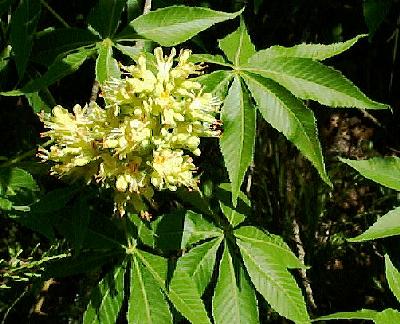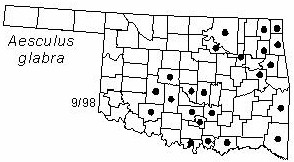
Shrub or small tree to 5 m (15 ft) tall. Twigs thick, red-brown, hairy when young, with large triangular leaf scars. Bark smooth, light gray, becoming rough and scaly on older stems. Leaves opposite, palmately compound, with long thin leafstalks. Leaflets 5-11, almost sessile, lanceolate, acuminate, unevenly serrate, 6-13 cm (2.5-5 in) long and 1-3 cm (0.4-1.2 in) wide, shiny yellow-green above, paler and hairy below. Flowers numerous in upright branched clusters 10-15 cm (4-6 in) long at ends of leafy branches, pale yellow, somewhat bell-shaped, 13-19 mm (0.5-0.8 in) long, blooming in Spring after the leaves appear. Fruits rounded capsules about 3 cm (1.2 in) diameter, somewhat leathery and spiny, maturing in Fall. Seeds 1-2 per fruit, large, hard, shiny, dark brown or black with a large paler basal spot.
Distribution: This variety is native to Missouri, Arkansas, Oklahoma, and Texas. The closely related Ohio buckeye (A. glabra var. glabra) is found through much of the Eastern Deciduous Forest.
Habitat: Usually in upland forests.
NWI status: FACU-
Comment: All parts of the plant are considered poisonous. It is sometimes cultivated as an ornamental shrub and the seeds are sometimes carried as good-luck charms. Aesculus is an old European name for some mast-bearing tree; glabra refers to the smooth leaves; and arguta refers to the sharp-pointed teeth on the leaflets.
Distribution in Oklahoma: 
BACK
NEXT
RETURN TO INDEX
Last update: 9/7/99
 Go to Oklahoma Biological Survey Home Page
Go to Oklahoma Biological Survey Home Page
 Disclaimer
Disclaimer